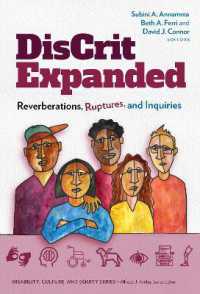- ホーム
- > 洋書
- > 英文書
- > Cinema / Film
Full Description
Given its features as a modern mass medium and thus closely related to the nation, cinema has rightly been regarded as a privileged site for putting forward and contesting representations of national identity, or in short, as a main arena in which narratives of national identity are negotiated. What do films such as Amores Perros or Traffic say about Mexican identity? In what way could Bread and Roses or The Crime of Padre Amaro be part of its transformation? This book looks at representations of "Mexicanity" in Mexican cinema and also in Hollywood throughout the twentieth century and beyond, arguing that the international context plays at least as important a role as ethnicity, religion and language in the construction of images of the national self, although it is seldom taken into account in theories of national identity. The Mexican film may reveal much about Mexican society, e.g.,Traffic and the prevalence of drug trafficking, Bread and Roses, and the problems of migration; Amores Perros, in relation to metaphors of the nation as an extended family; The Crime of Father Amaro, in discussing the changing position of the Catholic Church; and Herod's Law, a scathing critique to the political system that dominated Mexico for the best part of the 20th century. Throughout, the book emphasises the contingent nature of hegemonic representations, and our ongoing need to tell and to listen to - or indeed, view - stories that weave together a variety of strands to convincingly tell us who we are.
Contents
TABLE OF CONTENTS 7; INTRODUCTION 9; National Identity and International Relations 9; The Methodology 12; Empirical Corpus 15; Organisation of the Chapters 19; Part I; 1. Mexican Identity between the Revolution and the Cold Revolutionary Struggle 28; Defining the Political Field 29; Haciendas vs. Ejidos 30; Foreign vs. Domestic Investment 32; Bourgeoisie vs. Peasants and Working Class 34; Dependence vs. Independence 35; Legitimate vs. Illegitimate Government 36; Individual vs. Community 36; Resulting Subject Positions 37; The National Identity through Ethnicity 38; The National Identity through Religion 42; Equivalences and Differentiations 44; Chapter 2; THE DISCOURSE ON WORLD POLITICS 46; Producing 'the West' During the Cold War: Freedom, Democracy, Prosperity 46; The International Context 51; The Domestic Realm 54; The Discourse on Film 56; Negotiating The National Identity on Film 1910-1989 58; The Revolution as Discursive Horizon 58; Class, Ethnic and Gender Diversity Become a Unified 'We' 61; 'We' versus 'They' 63; Mexico Between the East and the West 64. Part 2; 2. After the Cold War: the Challenge; Chapter 3; CHALLENGES FROM 'OUTSIDE' 74; The Challenge to the East/West Divide 74; Producing the West After the Cold War: Development, Industrialisation, Secularism 74; Challenge to the Position in Relation to the U.S. 84; The Logic of the Supplement 84; Drug Trafficking Control 86; Illegal Migration 90; The Economy: the External Debt and NAFTA 94; The Challenge on Film: The View from Hollywood 99; Representations of Supplementarity 100; Traffic 104; Bread and Roses 110; Chapter 4; CHALLENGES FROM 'INSIDE' 117; Ethno-Linguistic Challenges to the Identity 117; The Indigenous Challenge 118; The Chicano Challenge 126; The Linguistic Challenge 133; The Religious Identity Challenge 135; Contending Interpretations 137; A Discursive Interpretation 140; The Challenge on Film: The View from Mexico 144; Representations of Mexico as a Member of the Post-Cold War 'West' 146; Challenges to the Ethnic, Religious and Political Dimensions of the Nation 149; Amores Perros (Love's a Bitch) 150; The Crime of Father Amaro 154; Herod's Law 160; CONCLUSIONS 165; AFTERWORD 167; BIBLIOGRAPHY 171; FILMOGRAPHY 183.








